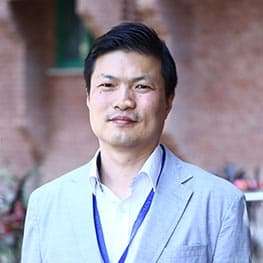DEPARTMENT OF ENVIRONMENTAL SCIENCES
Ph.D. (University of Seoul, Korea)
Master of Engineering (University of Seoul, Korea)
Dr. Shinho Chung is Associate Professor at the Department of Environmental Sciences, Forman Christian College (A Chartered University), Lahore, Pakistan. He joined FCCU in 2016. He has served more than 7 years as a lecturer at different universities in Korea. Served as Korea Overseas Volunteer at National Institute of Health, Islamabad, Pakistan (1999~2002), Senior researcher of Institute of Urban Sciences in University of Seoul (2005~2006), Professor of Department of Water and Environmental Engineering, Kabul Polytechnic University, Afghanistan (2007), IT director of Bagram Korean Hospital, Afghanistan (2008~2009), and Deputy Director of Energy and Environment Division, Newentec Co., Korea (2011~2015). Now he is actively doing research work mostly in the topic of Membrane Bioreactor as well as arsenic removal in drinking water.
Research interests:
Water and Wastewater Treatment, Development of Performance Indicator of Water Supply System, Currently doing research work on Membrane Bioreactor and utilizing Quorum Quenching technique, and a project on Arsenic removal from groundwater
Publications:
- Islam, Z. U., Ayub, M., Chung, S., & Oh, H. 2022. Effect of Aeration Intensity on Performance of Lab-Scale Quorum-Quenching Membrane Bioreactor. Membranes, 12(3), 289.
- Islam Z., Rose J., Ahmed S. and Chung, 2020. Quorum Quenching Cell Entrapping Bead by Polyvinyl Alcohol Method for Biofouling Mitigation in Lab-scale MBR, NUST Journal of Engineering Sciences, 13(1): 29-36.
- Ayub, M., Saeed, N., Chung, S., Nawaz, M. S., & Ghaffour, N. 2020. Physical and economical evaluation of laboratory-scale membrane bioreactor by long-term relative cost-benefit analysis. Journal of Water Reuse and Desalination, (10.3), 239-250.
- Ahmed, S., Chung, S., Sohail, N., Qazi, I. A., & Justin, A. 2020. Application of cell entrapping beads for Quorum Quenching technique in submerged membrane bioreactor. Water Science and Technology, 81(4), 744-752.
- Sohail, N., Ahmed, S., Chung, S., & Nawaz, M. S. 2020. Performance comparison of three different reactors (MBBR, MBR and MBBMR) for municipal wastewater treatment. Desalination and Water Treatment, 174 ; 71-78.
- Chung, S., Lee, H., Yu, M., Koo, J., Hyun, I., and Lee, H. 2005. Identification of key local factors influencing revenue water ratio of Korean cities using principal component analysis and clustering analysis. Water Science and Technology: Water Supply5 (3–4): 197–208.
- Lee, H., Chung, S., Yu, M., Koo, J., Hyun, I., and Lee, H. 2005. Applicable background minimum night flow for leakage management of small district metered areas in Korea. Water Science and Technology: Water Supply5 (3-4): 181-188.
- Yu, M.J., Ahn, S.K., Chung, S.H., Noh, S., Park, J.A., Rhim, Y.T., Jheong, W.H. and Chung., H.M. 2006. Evaluation of the rapid filtration system with particle size distribution and Cryptosporidium in different operating conditions. Water Science and Technology: Water Supply6 (1): 129–139.
- Chung, S., Lee, H., Yu, M. and Koo, J. 2006. Performance Evaluation of Water Loss Management in Urban Areas Using Different Performance Indicators, Journal of Korean Society of Environmental Engineering28(2): 117-127.
- Chung, S., Yu, M., Koo, Lee, H., and Koizumi, A. 2005. Applicability Test of Various Performance Indicators for Water Loss Management in Korean Cities. IWA Leakage 2005:1-11.
- Chung, S., Kim, K. and Koo, J. 2005. Selection of the best scaling factor of performance indicator for water distribution network. The Korean Society of Water and Wastewater,119-126.
- Chung, S., Lee, H., Koo, J., Yu, M. and Choi, J. 2004. A study on daily and hourly peak factor of water distribution districts. Korean Society of Water Quality, 143-152.
- Chung, S., Jang, M., Lee, H., Koo, J. and Yu, M. 2004. Factors affecting to water usage in residential area. Korean Society of Water Quality. 397-400.
- Chung, S., Lee, H., Koo, J. and Yu, M. 2003. Estimation and application of minimum night flow. Korean Society of Water Quality. 57-60.
- Chung, S., Lee, H., Koo, J. and Yu, M. 2003. Characterization of the ratio of revenue water in the 79 cities by Principal Component Analysis and Clustering Analysis. Korean Society of Water Quality. 133-142.
- Chung, S., Myung, K., Yu, M. and Ryu, S. 2002. A study on the optimum operational condition of Power Block Underdrain System. The Korean Society of Water and Wastewater. 79-82.
- Chung, S., Park, S. and Yu, M. 1997. Removal of Nitrogen and Phosphorous in Biofilm Process Using Iron Plates as Attached Growth Media. Korean Society of Environmental Engineering. 702-705.
